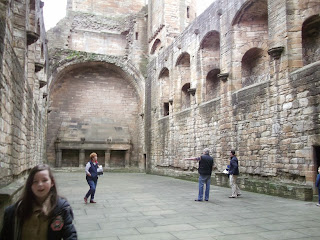 |
| James VI's North range from outside |
 |
| Hallway through East Range |
The castle first existed as a manor house that once stood as an important strategic point for Edward I of England during the Scottish Wars of Independence until 1424 when a great fire the building and surrounding village. Six years later, King James I of Scotland commissioned a new palace to be built in its place. In his lifetime the East range was built; the main attraction here is the Great Hall where many celebrations were held. There is also a kitchen and at that time royal lodgings, which were later rebuilt in the West range of the palace.
Over the years the palace was expanded; James IV added a chapel and new royal lodgings within the West range; James V added the exquisite fountain and the Southern entrance. Indeed, much of what stands today was completed at the time of Mary Queen of Scots' birth in December 1542. Mary herself added little to the palace decor, but she is closely associated with the visitor attraction today.
James I to James IV
 |
| James I's Great Hall |
Aside from the great hall, James I also had royal lodgings fitted and a grand entrance way in its centre. His grandson, James III went on to extend the royal lodgings, but it was James IV who completed the full quadrangle of the palace, During his reign James IV had a Chapel installed within the palace; its location the former royal lodgings of James I. He then expanded the palace further, adding lodgings to the West Range that are still visible today; a visitor can walk through the King's Hall to the Presence Chamber and then into the Bedchamber where the King slept which lead out onto the North Range.
 |
| King James IV's Presence Chamber |
 |
| The North Range commissioned by James VI |
As James IV's North Range no longer exists there is no way to know for sure, but the North Range that stands today was built during the reign of James VI after he had moved down to England. The style of the building indeed differs from the rest; according to Linlithgow's souvenir guide the building is designed similar to the Danish architecture of the time, which is possible as James VI's Queen was a Danish princess. He may have been influenced by the architecture when he journeyed there to meet his bride. There are indeed similarities within the building's wall structure and windows which resemble the works of Hans van Steenwinckel the Younger, architect to King Christian IV of Denmark (brother of Queen Anne).
 |
| Example of Steenwinckel's architectural style. |
 |
| James V's Fountain before East range entrance |
James V added a new southern entrance around 1535 that today is the main access point to the Castle ground. He also had a fountain built in the centre of the courtyard, a decorative display of James V's power and sophistication to the world. The Historic Scotland guide book explains that the fountain is a symbol of the union between Scotland and France through his first wife Madeleine de Valois, daughter of King Francis I,
'The tiered arrangement of three basins is surmounted by a crown is surmounted by a crown, representing the king's superiority. Water, symbolising the benefits of his rule, pours from the mouth of the sun-face on the underside of the crown... This is decorated with sculpted figures; these figures conveyed James' status as a patron of the arts.'
Tragically, Madeleine died within days of setting foot in Scotland.
The palace went on to be a part of his second wife's, Marie de Guise, dower lands and she gave birth to Mary Queen of Scots on 8 December 1542. It was here that she received word that James V died; history was repeating itself as James V had been born here in 1512. One year later, his father died at Flodden field; his mother was in residence at Linlithgow when she received word of James IV's death. Today, the highest point in the palace is still associated with his wife, known as Queen Margaret's Bower, where she is reputed to have lay in wait everyday for word of her husband as he headed south of the border to face the armies of Henry VIII.
 |
| View of the East range from the cellars |
Mary spent the first six months of her life here and didn't return for another 20 years, when she stayed only for a handful of days at a time. She had stayed here before setting off for Edinburgh when she was intercepted by the Earl of Bothwell and forced into a marriage that led to her forced abdication and imprisonment.
Upon James VI's move south, the palace began to decline. It was temporarily renovated when Charles I stayed for one night in 1633 on his progress through Scotland. This was the last time the palace was used as a royal residence. Bonnie Prince Charlie visited briefly on his journey to reclaim the throne in 1745. It was then destroyed on the the orders of the the Duke of Cumberland in January 1746.
Despite only the stone of the palace remaining today it still stands as a beautiful example of Scottish history with each subsequent Stewart King each engraving their own personal style upon the place for us to glimpse into their world.
Further reading:
Linlithgow Palace: The Official Souvenir Guide published by Historic Scotland.
No comments:
Post a Comment